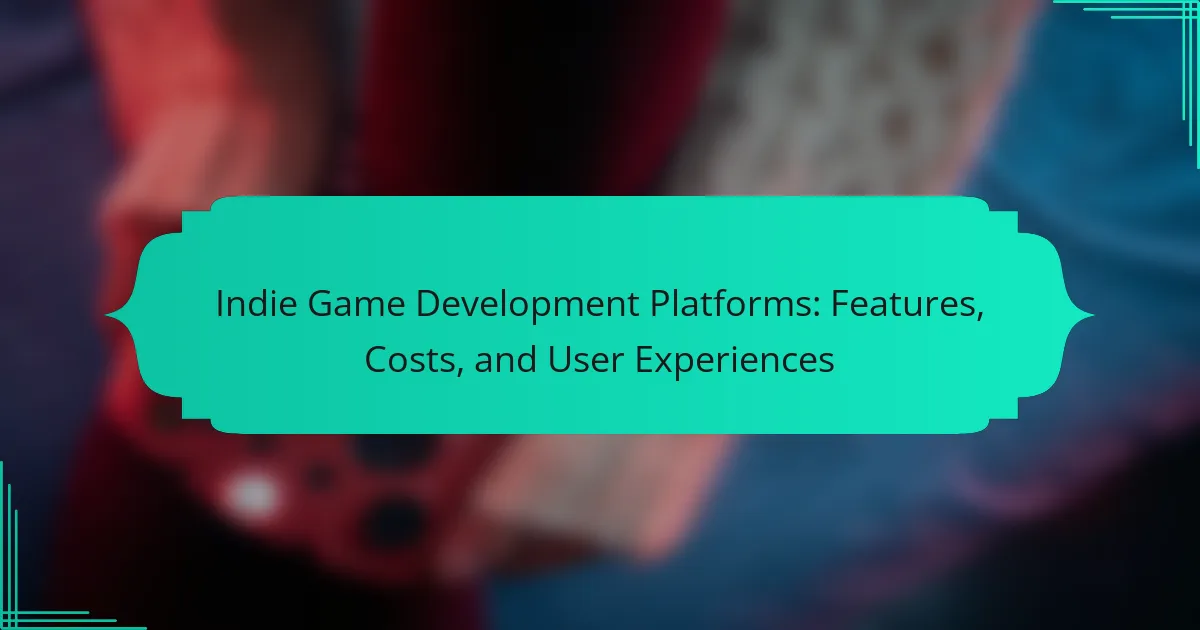Indie game development platforms provide essential tools for creating engaging games, yet choosing the right one can be challenging. This article explores features like user-friendly interfaces and asset libraries, examines costs associated with popular platforms such as Unity and Unreal Engine, and discusses user experiences that vary significantly across different options. Understanding these aspects will help developers make informed decisions to enhance their game development journey.

What are the key features of indie game development platforms?
Indie game development platforms offer features like user-friendly interfaces, extensive asset libraries, and cross-platform compatibility. These platforms often include integrated development environments, support for multiple programming languages, and community forums for collaboration. Additionally, many platforms provide monetization options and analytics tools to track user engagement. Cost varies widely, with some platforms offering free tiers and others requiring subscriptions or revenue sharing.
How do user interfaces vary across different platforms?
User interfaces across different platforms vary significantly in design, functionality, and user experience. Desktop platforms often prioritise detailed visuals and complex interactions, while mobile platforms focus on touch-friendly designs and simplified navigation.
For instance, indie game development platforms like Unity and Unreal Engine provide robust tools for desktop, offering extensive customisation options. In contrast, mobile platforms like GameSalad emphasise ease of use, catering to developers with limited coding experience.
Costs also differ, with desktop platforms often requiring higher initial investments for software licences, whereas mobile platforms may offer free versions with limited features. User experiences can be influenced by these factors, leading to varying levels of engagement and satisfaction depending on the platform chosen.
What programming languages and tools are commonly supported?
Indie game development platforms commonly support programming languages like C#, C++, and JavaScript, along with tools such as Unity, Unreal Engine, and GameMaker Studio. These languages and tools facilitate diverse game creation, enhancing user experiences and platform features.
Which platforms offer the best asset libraries and resources?
Platforms like Unity, Unreal Engine, and Godot offer extensive asset libraries and resources for indie game development. Unity features the Asset Store with thousands of assets, while Unreal Engine provides a Marketplace with high-quality resources. Godot has a growing community resource section, though it may not be as extensive. Each platform’s library enhances the development process, catering to various needs and budgets.
What collaborative features enhance team development?
Collaborative features that enhance team development include real-time editing, version control, and integrated communication tools. These features foster creativity and streamline workflows among team members. For instance, platforms like Unity and Unreal Engine allow simultaneous collaboration, which accelerates project timelines. Additionally, task management tools improve organisation and accountability, ensuring everyone knows their responsibilities.

How do costs compare among popular indie game development platforms?
Costs among popular indie game development platforms vary significantly based on features and user experiences. Unity offers a free tier, with professional plans starting at £399 annually. Unreal Engine utilises a royalty model, charging 5% on gross revenue after the first £1 million. GameMaker Studio 2 has a one-time fee of £99 for the Creator edition and £1,500 for the Master collection. Construct 3 operates on a subscription model, costing £16.50 monthly. Godot is entirely free with no licensing fees. Each platform’s pricing reflects its capabilities, target audience, and monetisation strategies.
What are the typical pricing models and subscription plans?
Indie game development platforms typically offer various pricing models, including subscription plans and one-time fees. Subscription plans often range from £10 to £50 per month, depending on features and support levels. Some platforms provide tiered pricing based on user needs, with higher tiers offering advanced tools and services. One-time fees can vary significantly, from £100 to several thousand pounds, depending on the platform’s capabilities and licensing terms.
Are there any hidden costs associated with specific platforms?
Yes, hidden costs can arise when using indie game development platforms. These may include transaction fees, subscription upgrades, and costs for additional assets or tools. For instance, some platforms charge fees on revenue generated, which can impact overall profitability. It’s crucial to review the pricing structure thoroughly to avoid unexpected expenses.
How do free platforms stack up against paid options?
Free platforms often offer limited features compared to paid options, which provide advanced tools and support. Free platforms may lack essential resources such as customer service, high-quality assets, and comprehensive documentation. Paid platforms typically include features like enhanced graphics capabilities, collaboration tools, and regular updates, enhancing user experience. For instance, Unity offers a free version with basic functionalities, while its paid plans unlock professional-grade tools, making it suitable for serious developers.

What are the user experiences like on different indie game development platforms?
User experiences on indie game development platforms vary significantly based on features and costs. Platforms like Unity and Unreal Engine offer extensive resources and community support, enhancing user satisfaction. In contrast, simpler platforms like GameMaker provide an easier learning curve but may lack advanced features. Costs also influence experiences; free options attract beginners, while paid platforms can offer more robust tools. Overall, user experiences are shaped by the balance of features, community engagement, and cost-effectiveness.
How do users rate the learning curve for various platforms?
Users generally rate the learning curve for indie game development platforms as moderate to steep, depending on the platform’s complexity and features. Platforms like Unity and Unreal Engine are often cited for their extensive capabilities, which can lead to a longer learning process. In contrast, simpler platforms such as GameMaker Studio receive higher ratings for ease of use, attracting beginners. User feedback highlights that hands-on tutorials and community support significantly ease the learning curve, making platforms more accessible.
What are common user challenges and frustrations?
Common user challenges in indie game development platforms include high costs, steep learning curves, limited features, and inadequate support. Users often express frustration with complex interfaces and insufficient documentation. As a result, many developers struggle to effectively utilise these platforms. Additionally, inconsistent performance and compatibility issues can hinder the development process.
How does community support influence user satisfaction?
Community support significantly enhances user satisfaction on indie game development platforms. Engaged communities provide valuable feedback, foster collaboration, and create a sense of belonging. This interaction leads to improved user experiences as developers receive direct input on their projects. Additionally, active forums and support networks enable users to troubleshoot issues collectively, further increasing their satisfaction and retention.

Which indie game development platforms are most popular in 2025?
The most popular indie game development platforms in 2025 include Unity, Unreal Engine, Godot, GameMaker Studio, and Construct. Each platform offers unique features, costs, and user experiences that cater to different developer needs.
Unity is favoured for its extensive asset store and cross-platform capabilities, making it versatile for various game types. Unreal Engine stands out with its high-quality graphics and robust tools for 3D development. Godot is known for its open-source nature and lightweight design, appealing to indie developers seeking flexibility. GameMaker Studio simplifies 2D game creation with its user-friendly interface, while Construct allows for rapid prototyping without extensive coding knowledge.
Costs vary significantly; Unity and Unreal Engine have free tiers but charge for advanced features, whereas Godot is entirely free. User experiences differ, with Unity and Unreal providing comprehensive support and community resources, while Godot is praised for its documentation and ease of use.
What trends are influencing platform choice among indie developers?
Indie developers are influenced by trends such as accessibility, cross-platform compatibility, and community support when choosing development platforms. The rise of user-friendly tools lowers entry barriers, while demand for multi-platform releases drives the need for versatile engines. Additionally, active communities provide invaluable resources and support.
How do regional preferences affect platform popularity?
Regional preferences significantly influence platform popularity by catering to local gaming cultures and trends. For instance, platforms that support specific languages or regional payment methods tend to attract more users. Additionally, local game genres and themes resonate more with regional audiences, driving platform engagement. User experiences vary based on these cultural factors, affecting community interaction and content creation. Thus, understanding regional preferences is crucial for indie game development platforms to thrive.

What unique attributes set specific platforms apart from others?
Unique attributes of indie game development platforms include specialised tools, community support, and pricing models. Platforms like Unity offer extensive asset stores, while GameMaker focuses on user-friendly interfaces. Unreal Engine stands out with its high-quality graphics capabilities. Additionally, platforms such as Construct provide robust educational resources, enhancing user experiences. Each platform’s unique attribute shapes the development process and influences user choice.
What innovative features are emerging in indie game development?
Innovative features in indie game development include enhanced accessibility tools, AI-driven game design, and community-driven content creation. These advancements improve user experiences and streamline the development process. For example, platforms now offer integrated tools for real-time collaboration, allowing developers to share assets and feedback instantly. Additionally, subscription-based models reduce upfront costs, making it easier for new developers to enter the market. Emerging technologies like virtual reality and augmented reality are also becoming more accessible, enabling unique gameplay experiences.
How do niche platforms cater to specialized genres or audiences?
Niche platforms effectively cater to specialized genres or audiences by offering tailored features and community engagement. These platforms often provide unique tools for indie game developers, such as customisable game engines and user-friendly interfaces. Costs are typically lower than mainstream platforms, making them accessible for small developers. User experiences are enhanced through focused support, forums, and resources that align with specific interests, fostering a sense of community and collaboration among creators.

What best practices can enhance the indie game development experience?
Utilising best practices can significantly enhance the indie game development experience. Focus on selecting the right platforms that offer essential features like user-friendly interfaces, robust support communities, and flexible pricing structures.
Consider platforms that provide comprehensive documentation and tutorials to streamline the learning process. Engaging with active forums fosters collaboration and feedback, which can improve game quality.
Regularly testing your game with diverse audiences can reveal valuable insights. Emphasising iterative development allows for continuous refinement based on user experiences.
Lastly, leveraging analytics tools can help track player engagement and identify areas for improvement, ensuring a more polished final product.
What strategies should developers adopt for successful project management?
Developers should adopt agile methodologies, clear communication, and effective planning for successful project management. Agile frameworks allow for iterative development, enabling quick adjustments based on user feedback. Clear communication fosters collaboration among team members, ensuring everyone is aligned with project goals. Effective planning involves setting realistic timelines and budgets, which helps manage resources efficiently. These strategies enhance productivity and improve overall project outcomes in indie game development.
How can developers effectively leverage community resources?
Developers can effectively leverage community resources by engaging with forums, attending events, and utilising collaborative platforms. These resources provide valuable feedback, networking opportunities, and access to a wealth of knowledge.
Participating in online forums like Reddit or specialised game development communities allows developers to share ideas and troubleshoot issues. Attending local or virtual meetups fosters connections with other developers, which can lead to partnerships and mentorship opportunities. Utilising platforms like GitHub encourages collaboration on projects, enhancing skill sets and broadening perspectives.
Incorporating these community resources into the development process can lead to improved game quality and a more supportive development environment.
What common mistakes should indie developers avoid when choosing a platform?
Indie developers should avoid common mistakes like neglecting platform fees, overlooking target audience preferences, and underestimating technical requirements. Choosing a platform with high revenue sharing can significantly impact profits. Additionally, failing to research community support can hinder development. Finally, not considering platform-specific features may limit game potential.
